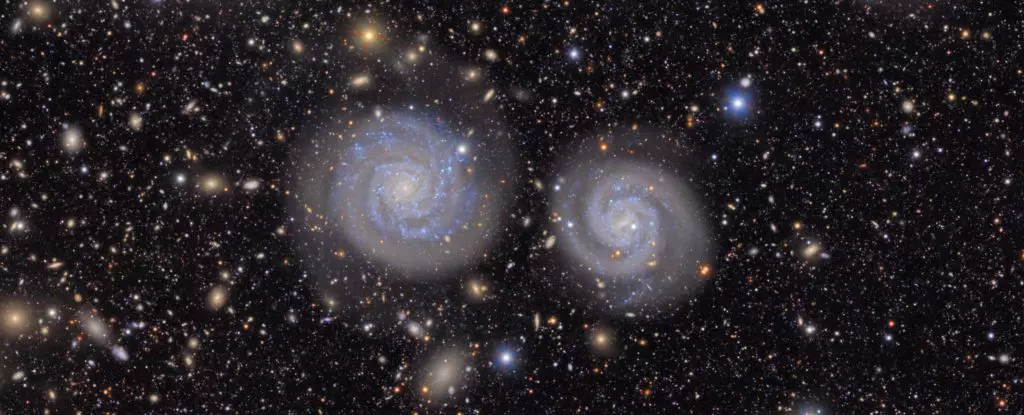The unveiling of the Vera C. Rubin Observatory marks not just the launch of another astronomical initiative, but heralds a transformative epoch in our quest for understanding the cosmos. After much anticipation, the observatory recently released its first images, providing a breathtaking glimpse into the depths of space. With the potential to alter our comprehension of the universe significantly, the observatory is equipped with cutting-edge technology that promises to generate more data in a decade than all of history’s optical telescopes combined. The implications of such a leap in observational capabilities cannot be overstated.
Director Brian Stone of the US National Science Foundation (NSF) aptly articulates the revolutionary impact of Rubin’s technology, emphasizing its role in exploring fundamental cosmic enigmas such as dark matter and dark energy. These elusive components constitute much of the universe’s makeup, and understanding them could unlock the door to some of physics’ most profound mysteries. With this observatory operational, we stand on the precipice of monumental revelations.
The Legacy Survey of Space and Time (LSST)
At the heart of the Rubin Observatory’s mission lies the Legacy Survey of Space and Time (LSST), a meticulous 10-year undertaking aimed at surveying the southern sky. By systematically capturing snapshots of the same locations up to 800 times throughout the decade, the LSST aspires to compile an unparalleled time-lapse record of cosmic events. Utilizing an extraordinary 3,200-megapixel camera—a feat of engineering that differentiates itself from all predecessors—the observatory can deliver resolutions and details previously relegated to the realm of science fiction.
This ambitious surveillance targets a broad spectrum of astronomical phenomena, from asteroids and comets to the explosive fury of supernovae. Astrobiologists and cosmologists alike can anticipate an exhaustive cataloging of objects within our solar system, as well as deep-sky observations revealing the most distant stellar explosions. Already in its initial images, the Rubin Observatory showcases an astonishing visual narrative, with the Trifid and Lagoon nebulae epitomizing the telescope’s ability to capture the universe’s complexities.
Astounding Discoveries
In just a fraction of its operational time, the observatory has begun delivering compelling results. An impressive example includes the detailed imaging of the Milky Way’s Trifid and Lagoon nebulae, created through a meticulous mosaic of 678 individual images spanning over 7.2 hours. This is not merely an achievement in terms of imaging but a testament to the scientific artistry that the Rubin Observatory embodies.
Further showcasing its capabilities, the observatory has provided a glimpse of around 10 million galaxies concentrated in the Virgo cluster. Viewers are invited to interact with this rich dataset, emphasizing the accessibility of groundbreaking astronomical research in contemporary society. With additional findings, including observations of 2,104 previously uncharted asteroids, the Rubin Observatory is crafting an expansive inventory that promises to revolutionize our understanding of celestial bodies. Such endeavors contribute vitally to planetary defense considerations, as the potential risks associated with these asteroids loom large in public consciousness.
Unraveling Cosmic Mysteries
The Rubin Observatory is unprecedented in its construction and operations—its mirror design, the sensitivity of its camera, and the rapidity with which it can conduct observations are elements not seen in any prior observatory. Thus, this facility isn’t just another addition to the astronomical toolkit; it’s a paradigm shift. The NSF and DOE’s assertions about the power of Rubin’s data highlight an enthusiasm that is palpable in the scientific community.
Moreover, as researchers dive into the troves of information generated by this observatory, we are likely to confront questions and challenges previously unimagined. Each layer of data collected by Rubin will demand innovative approaches and new methodologies to understand the universe’s evolution. This endeavor is not merely about accumulating data; it’s about reshaping our intellectual landscape in pursuit of knowledge.
As we stand at this juncture of astronomical advancement, the pursuit of understanding dark energy and dark matter may soon lead to insights that challenge existing theories and offer novel understandings of the universe. The Vera C. Rubin Observatory is not just observing; it invites all of us to ponder our place in the cosmos and contribute to this ongoing exploration of our grand universe.


Leave a Reply